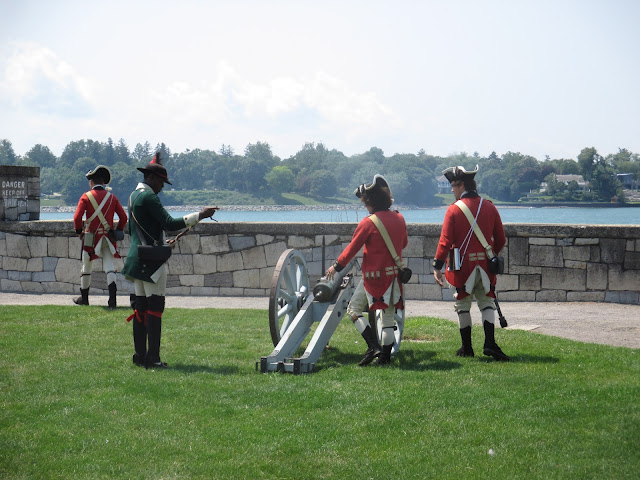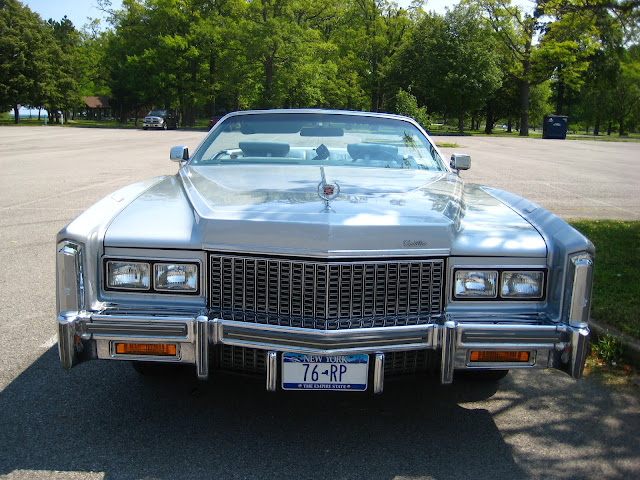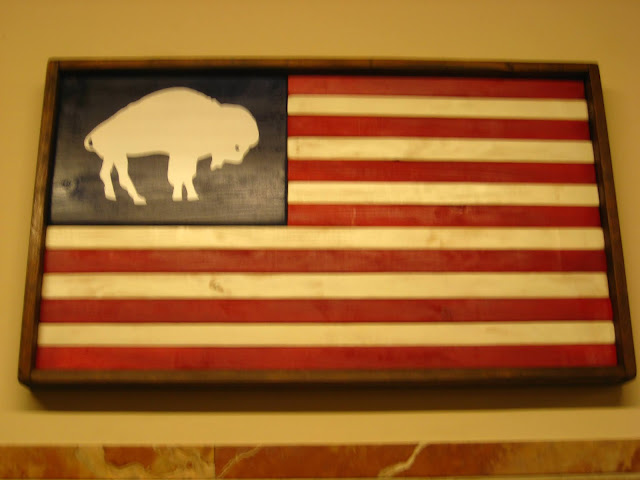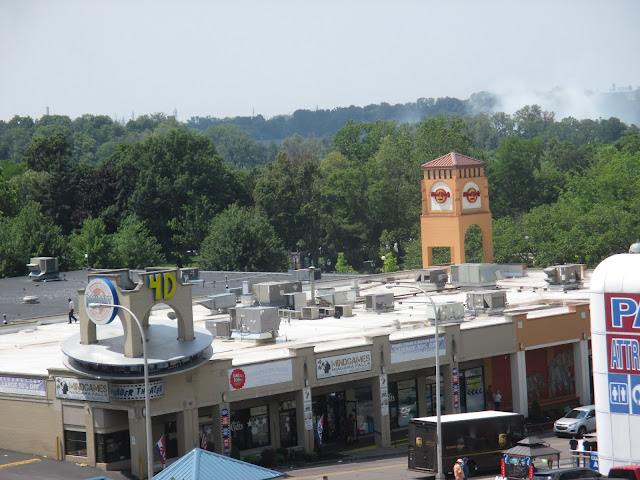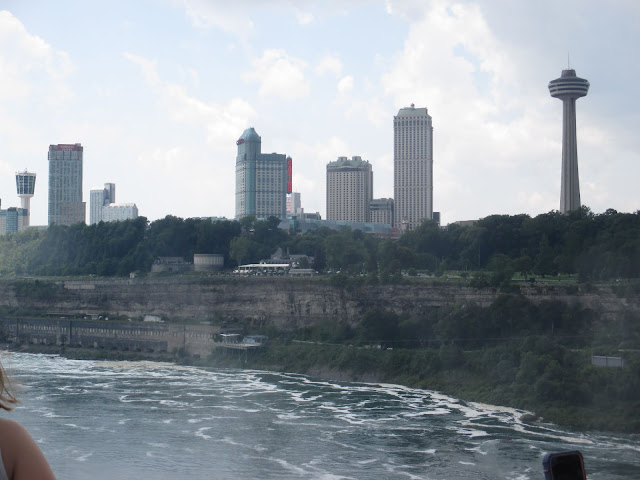July 27-28
The hotel had a book in the lobby with information about Buffalo-area restaurants.
So on Tuesday, our last full day in town, while the laundry was turning in the washer down the hall, I took a closer look at a place that seemed promising.
It had snails on the menu. That alone is enough to get me to drive eight or nines miles for dinner.
Besides, the place was called Hutch’s, and—who knows?—I could be helping out a distant cousin.
So we finished the laundry. Joanna, who used to work in a family laundry business, did the folding, and I found that I still remember how to iron a shirt. I’ve been leaving my shirts to the care of the professionals for years now and wasn’t sure I could remember how to handle the job.
I had sweated through one of my button-downs during our foray to the falls and City Hall on Monday and wouldn’t have a chance to have it cleaned before the end of our ride.
All right, I’ve washed and ironed shirts before. So I tried it again.
The room had a Conair steam iron that leaked water from time to time. A few passes of the hot iron evaporates that. OK. Sleeves, yoke, front, back, back, front. Oops. Missed something. Sleeve again. Done.
Domesticity just isn’t my strong suit. So when I held up that shirt and no part of it was burned, I felt like a medalist.
Then Joanna and I went to dinner. Hutch’s is easy to find—I-290 West to Delaware Avenue southbound. There’s a traffic circle just past of the restaurant, probably put in so when you miss Hutch’s it’s easy to turn around and come back to the driveway for the parking lot.
I know it’s convenient because I tested it.
I had to have the snails, and it turned out to be a night to eat creatures without backbones: Soft-shell crabs were in season.
Joanna and I split a half dozen snails. They were done in garlic and butter, but they were dressed with bread crumbs, too. Very nice. I put extra butter on the dish when it arrived to stretch out the experience.
Extra butter on escargot was a tip given to me by a bartender at the old Les Halles on Park Avenue, not far from my old office in New York.
It gives you more to dip your bread in after you’ve eaten all the snails.
Les Halles was the restaurant where Anthony Bourdain used to work. When he became a writer and TV celebrity, he was listed by the bistro as executive chef. Now, both he and Les Halles are gone.
The appetizer of soft-shell crab was coated in panko bread crumbs and pan-fried. It was delicious, as we expected. Soft-shell crab also has a place in Cantonese cuisine, so Joanna was familiar with it. But this was the first time she had it prepared in a different way.
We shared an entree of two more crabs in a cream sauce with new potatoes, string beans, and sweet red peppers.
We had it all with a white wine from Chateau Turcaud that was listed as a Cabernet Sauvignon. (Editor’s note: This is an error. Harry often mixes up his “sauvignons.” The issue is clarified below, in the July 29 e-mail exchange between Harry and Larry.)
I tried to learn more about it online, but all I could find was a blend under that label that had Cab Sauvignon in it. The official appellation is “Entre Deux Mers.” Maybe Larry can add more information.
In any event, it was one of the most flavorful whites I have tasted. Joanna liked it too. She went through almost half a glass of it.
We checked out of Buffalo on Wednesday morning and headed more or less north to Fort Niagara.
It’s in Fort Niagara State Park, which also has a swimming pool and other attractions on the shore of Lake Ontario. Although it’s in a state park, the fort itself has been maintained by a private non-profit organization since the 1930s or earlier.
I was there on my first trip to this area. It’s funny. When you’re eight years old a place seems bigger.
The fort has a colorful history.
According to a guide, the original parts, like the main building, earthworks, and powder magazine, were built by the French. They asked the Seneca if they could build something on the point where the Niagara River enters Lake Ontario. The Seneca said no way.
Not taking no way as an answer, they asked the Seneca’s neighbors, the Onandaga. May we build a peace house on the point to encourage trade among the peoples of the region?
Sounds good. Sure.
So the French built the main building, which today is called the French Castle. When the Seneca saw it, we were told, they were outraged. It was clearly a fortress, made of stone, with various defensive features, including overhanging dormers from which hot water or maybe rocks could be poured onto attackers. Even the well was indoors. Not very open-handed.
The Seneca and Onandaga were both members of the same club, the Iroquois Confederacy. So the Seneca had to abide by the decision.
That was in the late 1600s. And the French held the point for about 70 years.
In 1759, about the time that “The Last of the Mohicans” was set, the British laid siege to the fort. It took them three weeks and an ambush of a relief column, but they finally took over.
Then comes the Revolution.
When that was over, the Treaty of Paris said the fort was on the U.S. side of the Niagara River. The Brits, being sore losers, didn’t actually hand it over for almost 20 years. It has been safe for most of us to go there since then.
Well, not during the War of 1812, but I don’t want to go into that.
We got there in time to see a crew of re-enactors load and fire a cannon. They tell you ahead of time to protect your ears. As promised, “It will be loud, and you will like it.”
The Google directions to our next stop, in Batavia, were interrupted by a detour sign that sent us nowhere. Did the signs disappear? No, they were just placed facing away from the road.
Instead of bearing southwest toward Batavia, we wound up going northwest to New York Highway 18, which follows the shore of Lake Ontario.
I put on the flashers and pulled off the highway. We threw out the Google directions and went to a map. NY 18 East would take me to NY 98 South, which went straight to Batavia.
All right: go straight, make a right; that’s all. No shortcuts, no bullshit. My kind of directions.
But it seemed like forever on 18 E. Did I miss the turn?
We stopped at Lakeside Beach State Park. I put the map on the hood of the car. Luck was on our side. We hadn’t missed anything and were almost to the turn.
NY 98 South brought us to Albion. Are we going in alphabetical order, Joanna asked.
Then we entered Barre. Seems so.
The town of Elba, which came next, screwed that up, but then we came to Batavia.
I was waiting at a light and thinking about how to find our hotel when Joanna looked out her side window and said, “There’s a La Quinta over there.”
It wasn’t just any La Quinta. It was our La Quinta. Joanna to the rescue again.
According to TripAdvisor, we were less than a mile from the No. 1 restaurant in Batavia, Alex’s Place.
It was one of my favorite cuisines—damned good bar food.
Joanna had a roasted half chicken, very savory. I had a couple of local brews with my grilled shrimp, barbecued beans, and Mexican corn.
Eli Fish Brewing’s Great Flakes, billed as a session New York IPA, at 5 percent ABV, was made with all New York ingredients. A sniff at first didn’t detect much fragrance, but—surprise! surprise!—it packed a hell of a lot of flavor. There was a taint of citrus and an unusual aftertaste of salt.
It’s made in Batavia and may not be sold anywhere else, but let me tell you just in case, ale drinkers, if you see it, take it.
My second was 42 North Borderland IPA. Brewed near Buffalo, it carries just under 7 percent ABV. It has a sharp edge, which is nice, and a touch of grapefruit. Another very good one.
On the way home we stopped at a Tops supermarket where I found another six cans of Big Ditch Hayburner. I told you about that one.
That brings us up to date.
Good night, all, and God bless.
And don’t always trust your Google Maps.
Harry
July 29
Hi Grasshopper,
Entres Deux Mers is an interesting AOP (appellation) in Bordeaux that I believe is only for white wine. And while I didn't feel like Googling it, I think the "Deux Mers" are actually two rivers, the Gironde and another river (Dordogne maybe) that I forget. Google to confirm.
The wine would be a small step up from the more generic Bordeaux AOP, which is rarely white, and it includes mostly inexpensive wines.
While I guess it's technically possible to make white wine from Cabernet, it's rarely, if ever done. And I can't imagine it would be permitted in this AOP. Clearly, a mistake in the description you read.
Examples I have seen and sampled are generally a blend dominated by Sauvignon Blanc with Semillion to round it out. This is the classic blend for dry whites in Bordeaux.
Because of the warmer climate moderated by the proximity to the Atlantic Ocean and the addition of Semillon, the Sauvignon Blanc flavor is less pungent, sharp and "cat pissy" than it is in wines from further north and inland in the Loire valley.
It's always fun to enjoy a new discovery.
Larry
July 29
Oh, what a typo.
The grape was Sauvignon Blanc.
My only excuse is that I was half in the bag at the time I typed it.
Thanks for the lowdown on the appellation, Sensei.
Grasshopper








